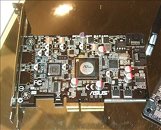- Joined
- Oct 9, 2007
- Messages
- 47,848 (7.39/day)
- Location
- Dublin, Ireland
| System Name | RBMK-1000 |
|---|---|
| Processor | AMD Ryzen 7 5700G |
| Motherboard | Gigabyte B550 AORUS Elite V2 |
| Cooling | DeepCool Gammax L240 V2 |
| Memory | 2x 16GB DDR4-3200 |
| Video Card(s) | Galax RTX 4070 Ti EX |
| Storage | Samsung 990 1TB |
| Display(s) | BenQ 1440p 60 Hz 27-inch |
| Case | Corsair Carbide 100R |
| Audio Device(s) | ASUS SupremeFX S1220A |
| Power Supply | Cooler Master MWE Gold 650W |
| Mouse | ASUS ROG Strix Impact |
| Keyboard | Gamdias Hermes E2 |
| Software | Windows 11 Pro |
ASUS implemented an interesting design with its high-end P7P55D Premium motherboard, that makes use of a PLX PEX8613 3-port/12-lane PCI-E 2.0 bridge chip across its PCI-E 1.1 x4 from the PCH to drive the Marvell 88SE9123 2-port SATA 6 Gbps controller to its full-potential. Apparently the company plans to provide SATA 6 Gbps support using essentially the same design, for all its Intel P55 series motherboards by means of an optional addon card. Much larger than the SATA 6 Gbps card from ASRock, the card from ASUS uses the same basic design that involves PLX PEX8613 as a PCI-E x4 device. The card uses the same SATA 6 Gbps controller to provide 2 internal SATA ports. From the looks of it, the card has placeholders for two controllers, with the second (absent) NEC µPD720200 controller providing USB 3.0 ports. Perhaps a future revision makes use of it. Planned to be offered as an optional accessory, this card could make for a premium over the base models.

View at TechPowerUp Main Site

View at TechPowerUp Main Site
Last edited:








